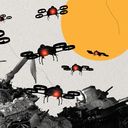The future of war will be AI-driven cheap drone swarms

Swarms of low-cost drones powered by AI — perhaps hundreds of them at the same time — could soon pose an existential threat to America's hulking war machinery.
Why it matters: Advanced militaries can largely fend off individual drones. But swarms of them deployed on a single target have the potential to reshape the global balance of power.
The big picture: Future battles will be fought with a connected mix of cheap weapons — not sophisticated weapons systems that only superpowers can afford, retired Adm. James Stavridis and Marine veteran Elliot Ackerman argued yesterday in a Wall Street Journal essay.
- Expensive aircraft carriers or stealth bombers, which require massive time commitments to develop and build, will become vulnerable to drones that almost every military and armed group can access.
- "This moment hasn't yet arrived, but it is rushing to meet us," Stavridis and Ackerman write.
Zoom in: The use of lethal drones has exploded in conflicts around the world.
- They've changed the trajectory of the war in Ukraine multiple times.
- Houthi militants are aiming them at ships.
Those are largely point-and-shoot weapons controlled remotely by individual combatants, and American soldiers and ships are typically capable of shooting them down.
- But if they're deployed in a swarm, Iranian-supplied drones that cost thousands of dollars each could take on multibillion-dollar warships.
State of play: The Pentagon is racing to develop a defense against swarms while building AI-coordinated drone systems of its own.
- The Defense Department has signed at least five deals with contractors that explicitly reference swarming, according to a report from the Center for Security and Emerging Technology that examined procurement contracts from 2020.
- Army Gen. Erik Kurilla, commander of U.S. Central Command, told the Senate Armed Services Committee last week that cheap drones are "one of the top threats," and called swarms an even bigger concern.
- He said the U.S. should "continue to invest in things like high-powered microwave" weapons to defend against mass drone attacks.
- Another Pentagon initiative known as "Replicator" is building "thousands of autonomous systems" over the next 18 to 24 months to counter the Chinese military's rapid buildup.
The bottom line: In the future, the "winning side will be the one that's developed the AI-based decision-making that can outpace their adversary," Stavridis and Ackerman write.
- "Warfare is headed toward a brain-on-brain conflict."